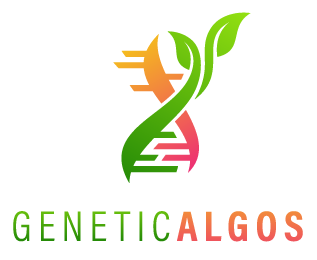GeneticAlgos is a simple and powerful Python library for creating genetic algorithms to solve complex optimization problems. GeneticAlgos is built on NumPy and it is under active development.
- Uses smart defaults for genetic algorithms parameters which are good enough for generic use cases or for testing.
- A simple-to-use API to modify genetic algorithms parameters.
- Lightweight and just one dependency - Numpy.
- Excellent test coverage.
- Tested on Python 3.7, 3.8, 3.9 and 3.10
Online documentation is available at https://geneticalgos.readthedocs.io/en/latest/.
The docs include a introduction to genetic algorithms, examples, advanced usage, and other useful information.
geneticalgos is available on PYPI.
Install with pip:
$ pip install geneticalgosTrivial example:
We want to find a set of X=(x1, x2, x3, x4) which maximizes sum(x1, x2, x3, x4), when each element x is a float from interval (0, 10). Simple answer is: x1 = 10, x2 = 10, x3 = 10, x4 = 10. First, we define our fitness function (sum) and then gene_intervals for each x.
All other parameters (population size, crossover method, mutation probability, ...) are configured with default values. However, you can change and tweak them easily - Advanced usage.
import geneticalgos as ga
import numpy as np
def custom_fitness_function(chromosome):
return sum(chromosome)
gene_intervals = np.array([[0, 10]] * 4)
# Create genetic algorithms with default values for GA parameters
# and our fitness function and gene intervals
ga_model = ga.GeneticAlgo(
fitness_function=custom_fitness_function,
gene_intervals=gene_intervals,
)
# Start genetic algorithm simulation
ga_model.simulate()
# print best solution
print(ga_model.best_chromosome)
# print fitness value for best chromosome
print(ga_model.best_fitness)The main goal of the GeneticAlgos is to be simple and powerful.
- Simple, because it can be used with basic knowledge of python (data structures, functions, ...).
- Simple, because it can be used with basic knowledge of genetic algorithms (population, chromosome, fitness function, ...).
- Powerful, because we can tweak many genetic algorithms parameters very easily and create complex models with the minimum of configuration.
Let's be honest, genetic algorithms are very complex algorithms which have a lot of modifications from a standard scheme.
You should look somewhere else if you need:
- Something other than binary or numerical encoding - like permutation, strings, ...
- Chromosome genes with different encoding within same chromosome - some genes are float numbers and some of them integers.
- An end criterion that is different from a fixed number of generation cycles.
If you encounter any problems, please file an issue along with a detailed description. Thank you 😃
Created by Lukas Kozelnicky.
Distributed under the MIT license. See LICENSE.txt for more information.




